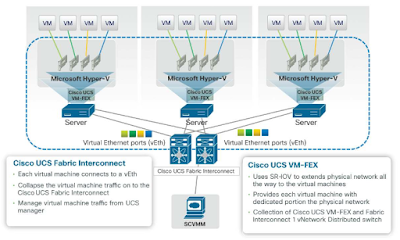Cisco Virtual Networking
I was
working as a virtualization administrator 9 years ago and I still
remember how the virtualization team had to configure and manage the
virtual network. The main tasks of the virtualization team were to
create and manage virtual machines but, from time to time, we also
had to manage the virtual network. I always thought networking should
be managed by the networking team regardless of virtual or physical,
but the networking team said everything virtual should be managed by
the virtualization team. It was chaotic.
Actually,
I already really loved networking and I didn’t mind to manage
virtual networks but roles and responsibilities were not clarify
defined. Therefore, nobody applied network and security policies
between virtual machines and nobody wanted to troubleshoot
communication problems between virtual machines. However, clear
separation of roles could already be got with technologies such as
Nexus 1000V and VM-FEX. These two technologies help organizations to
address these problems.
 |
| Cisco Virtual Networking Solution Options |
Cisco
Virtual Networking solutions, such as VM-FEX and Nexus 1000V, help
customers to reduce the operational complexities and take advantages
of virtual technologies. For instance, virtual networks can be
managed in the same way that physical networks because we’ll have
the same command line (Cisco NX-OS CLI) and network administrators
won’t have to be retrained. In addition, we’ll use the same
monitoring and management tools to manage both environments. What’s
more, we will be able to apply network and security policies between
virtual machines.
I’ve
already written about Cisco
Nexus Fabric Extender (FEX), which removes the line cards
from the modular switch with the aim of installing remote line cards
as ToR switches. However, these remote line cards are like virtual
wires to the Parent Switch where the management, control and data
plane are carried out. VM-FEX is the same Cisco FEX technology but it
is applied to the virtual environment thus VM-FEX extends the
physical network to virtual machines.
 |
| Cisco VM-FEX Extends Cisco Fabric Extender Technology with Cisco UCS Fabric Interconnects |
One of the
main benefits of VM-FEX is the operation simplicity because both
environment, virtual and physical, can be managed with the same tools
and same networking administrators. However, another interesting
advantage is the improved performance because SR-IOV functionality,
enabled into the virtual platform, offers near-bare-metal performance
for virtual workloads.
Finally,
the Cisco Virtual Networking solution Cisco Nexus 1000V Series
extends networking functions to the hypervisor
layer. This solution has two components. The Virtual Ethernet
Module (VEM), which is a software line card connected to each virtual
machine, and the Virtual Supervisor Module (VSM), which is the
management module for controlling multiple VEMs. This solution has
lots of advantages, like VM-FEX does, but I think the main advantage
is the hardware requirements because Cisco Nexus 1000V Series is a
software solution while VM-FEX required dedicated hardware.
 |
| Cisco Nexus VEM and VSM Components |
That’s
all my friends. Two Cisco Virtual Networking solutions for your
portfolio. Keep learning and keep studying!!










Commentaires
Enregistrer un commentaire